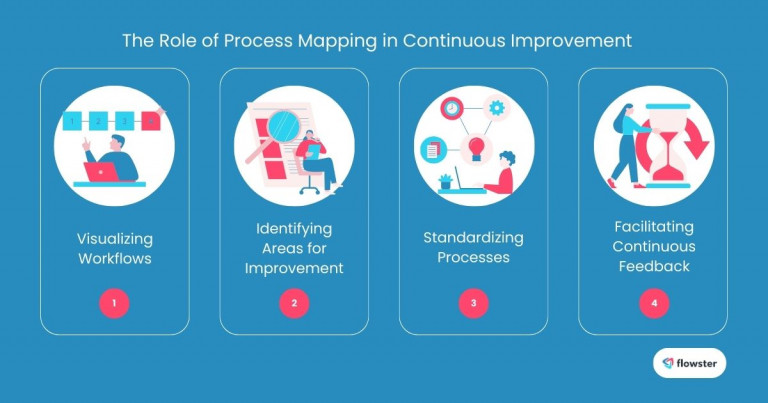In today’s fast-paced business world, staying ahead often requires a commitment to continuous improvement. For small and medium business owners and entrepreneurs, finding efficient ways to streamline operations can significantly impact growth and success. This is where process mapping comes into play, serving as a crucial tool for understanding and enhancing workflows.
In this article, we’ll explore the role of process mapping in continuous improvement. We’ll discuss how methodologies like Lean and Six Sigma leverage process mapping to identify inefficiencies and drive ongoing enhancements in business processes. Let’s dive into how you can start shaping your business for a more efficient future!
Article Outline
What is Process Mapping?
Process mapping is a visual representation of the steps involved in a business process. It outlines how tasks are completed, who is responsible for each step, and how different activities are interconnected. This clarity makes it easier for teams to understand their workflows and identify areas for improvement.
In the context of process mapping in continuous improvement, this tool becomes invaluable. Through process mapping, organizations can gain a comprehensive understanding and identify inefficiencies that could otherwise remain undetected. Ultimately, effective process mapping sets the foundation for ongoing enhancements, enabling businesses to work smarter, not harder.
Understanding Continuous Improvement
Continuous improvement is a philosophy aimed at enhancing business processes, products, or services over time. It focuses on making incremental changes that lead to better efficiency, higher quality, and increased customer satisfaction. For small and medium business owners, embracing continuous improvement can be a game-changer in today’s competitive landscape.
Key methodologies, such as Lean and Six Sigma, underscore the importance of systematic improvement. Lean emphasizes waste reduction, while Six Sigma focuses on minimizing variability and defects. Both strategies effectively integrate process mapping in continuous improvement, helping teams visualize their workflows and identify specific areas where enhancements can be made.
To learn more about why standard processes are essential for fostering continuous improvement, check out this insightful article: Powerful Reasons Why Standard Processes Are Essential.
Flowster's AI-Driven Automation
The Role of Process Mapping in Continuous Improvement
Process mapping plays a pivotal role in the journey of continuous improvement by providing a clear visual representation of workflows. This tool helps organizations identify inefficiencies and standardize best practices, ensuring that all team members are aligned. By integrating process mapping in continuous improvement, businesses can foster a culture of ongoing enhancement and responsiveness to change.
1. Visualizing Workflows
One of the primary benefits of process mapping is its ability to provide clarity and transparency within workflows. When processes are visually mapped out, it becomes easier to identify inefficiencies and bottlenecks that may hinder productivity. This visualization fosters collaborative discussions among team members, as everyone can see the workflow and contribute their insights.
2. Identifying Areas for Improvement
Process mapping plays a vital role in pinpointing specific areas that need improvement. By analyzing the flow of tasks, businesses can identify redundancies and delays that affect overall performance. Utilizing process mapping in continuous improvement allows organizations to make data-driven decisions that lead to tangible results.
3. Standardizing Processes
Another significant advantage of process mapping is its ability to create consistency across the organization. By standardizing processes, businesses ensure that everyone follows best practices, which reduces errors and increases efficiency. This is especially beneficial for training new employees, as clear process maps simplify the onboarding experience.
4. Facilitating Continuous Feedback
Process mapping supports a culture of continuous feedback by making it easy to update workflows based on team input and changing business needs. Iterative improvements can be implemented quickly, helping businesses adapt to new challenges. Embracing process mapping in continuous improvement allows organizations to remain flexible and responsive in a constantly evolving market.
For further insights on overcoming inefficient processes, check out this helpful article: 5 Strategies to Overcome Inefficient Processes.

Practical Steps to Start Process Mapping
Starting with process mapping involves a few strategic steps that can lead to meaningful improvements in your business operations. By gathering your team, identifying key processes, and creating your first process map, you set the stage for effective workflow analysis. Embracing process mapping in continuous improvement will help your organization streamline operations and boost overall efficiency.
Step 1: Gather Your Team
The first step in effective process mapping in continuous improvement is to assemble your team. Involve key stakeholders who understand the processes well, as their insights will be invaluable. Collaborative input fosters ownership and ensures that everyone is in agreement.
Step 2: Identify Key Processes
Next, determine which processes to map. Focus on those that significantly impact efficiency and customer satisfaction. Prioritizing these processes will help you maximize the benefits of your mapping efforts and address the most critical areas.
Step 3: Create Your First Process Map
Once you have your team and processes identified, it’s time to create your first process map. Use simple tools or software to visualize the workflow. For beginners, leveraging free workflow templates can simplify the process. Remember, process mapping in continuous improvement is an iterative journey; your first map doesn’t have to be perfect.
To deepen your understanding of process mapping and task management, check out this informative article: Guide to Mastering Process Maps for Task Management.
Capture Your Processes in Minutes!
Conclusion: Unlocking Business Potential through Process Mapping in Continuous Improvement
In summary, process mapping in continuous improvement is a powerful tool that can transform the way small and medium businesses operate. By visualizing workflows, identifying inefficiencies, and standardizing processes, organizations can create a culture of ongoing enhancement. This approach not only boosts productivity but also improves employee engagement and customer satisfaction.
As you explore the benefits of process mapping, remember that the journey toward continuous improvement starts with a single step. I encourage you to take action today by mapping your own business processes. To make it easier, visit Flowster Marketplace to access free workflow templates that can help you kickstart this vital initiative. Your path to greater efficiency and success begins now!




